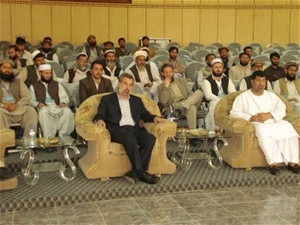
The agreement with the Ministry of Mines was announced at a Nuristani Gemstone Association general assembly meeting.
USAID/ASMED
Nuristani Gemstone Association achieves legal status for its members.
13 OCTOBER 2009 | NURISTAN, AFGHANISTAN
Afghanistan contains sizable deposits of precious and semi-precious stones, including emeralds, sapphires, tourmaline, and lapis lazuli, and the gem industry has the potential to be a major driver of economic growth. In the remote eastern province of Nuristan, blue and pink tourmaline, kunzite, and aquamarine have been mined for generations. Yet, until recently, mining and selling gemstones was illegal. Legal provisions for trade in gemstones – considered the property of the Islamic Republic of Afghanistan – did not exist.
To strengthen and legalize this important sector, the Nuristani Gemstone Association recently signed a landmark agreement with Afghanistan’s Ministry of Mines that recognizes the association’s trade and sale of gemstones in the province.
USAID assisted in the creation of the Nuristani Gemstone Association so that member gemstone businesses could pursue their economic interests collectively. The legalization of the gemstone trade, the result of sustained engagement with the Ministry since June 2008, is an excellent example of the benefits that business association advocacy provides.
Since mining began in the 1970s, it has been one of Nuristan’s largest employers, providing many livelihoods even during times of illegality. However, because the activity was illicit, gemstones were smuggled into Pakistan to be cut, polished, and sold. Thus, most of the value was added outside of Afghanistan. Now, the country can become known as a source of quality cut and polished gemstones.
Legalization provides many benefits. There will be new incentives for the creation of gemstone-related businesses as firms capture the value of these stones within the borders of the country. The formalization will also catalyze investment and generate employment and income. USAID will continue to support the sector through local gemstone bazaars, supplier conferences, and gemology training.
The Ministry of Mines will officially lease selling rights, and will tax the sales of gemstones. These funds will support infrastructure improvements in Nuristan. This process allows the government to show that taxes are used to improve the lives of citizens.







Comment
Make a general inquiry or suggest an improvement.